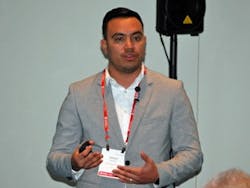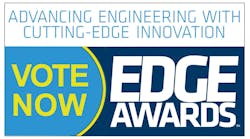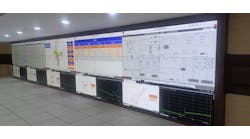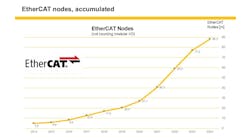“We chose PlantPAx because it would save a lot of time, as engineers could focus on the process, connections and high-end programming.” ECN Automation’s Sergio Alzate on the choice of the Rockwell Automation DCS platform for Excelsior’s innovative copper mining operation.
Excelsior Mining’s Gunnison Project near Tucson, Arizona, began in 2018 and is projected to produce more than 2 billion lb of copper over its 24-year life using an unusual in situ leaching process.
Rockwell Automation Solution Partner ECN Automation designed a complete solution for the Gunnison Project’s process-control platform. PlantPAx DCS was selected due to availability of local support, industry references and a standardized programming environment that the local community of system integrators could support. It was also important to be able to integrate smart instrumentation to gather intelligence from the process field operations.
“In 2017, I was part of the project with ECN,” said José Carlos Palazuelos Spence, regional sales representative, Endress+Hauser (E+H), who presented with Sergio Alzate, project manager, ECN Automation, at the Rockwell Automation Process Solutions User Group (PSUG) meeting this week in Chicago. “In late 2017, an engineering/procurement/construction (EPC) company came to us needing help from a system integrator (SI) for a new type of process. It had been used for uranium, but they wanted to use it for copper.”
Instead of mining in a traditional way, in situ recovery (ISR) is done by drilling wells, pumping weak sulfuric acid into the ore, extracting the leachate and taking out the copper in an electrowinning facility. The first stage involved 41 wells to inject and extract the acid with water, to produce a total of 2 billion lb of copper at a rate of 125 million lb/year. The initial cost would be $49 million, and the project would pay back in 4.6 years—an internal rate of return (IRR) of 48%—with a production cost of $0.66/lb compared to a typical $1.80-$2.10/lb by conventional mining and extraction.
“The EPC wanted an SI with local expertise who could provide continued support,” Palazuelos Spence said. “They needed HART, Modbus and Ethernet to cover the required equipment and instrumentation. The site had some existing infrastructure from a previous, unfinished planned facility, but we were to recreate from scrap except for an existing filter.”
Development time was short, and the budget was limited, “as this is a publicly traded company,” Palazuelos Spence said. “They needed flexibility as the process definition was still changing, and the resulting system needed to be easy to operate and maintain.
“They wanted an SI that understands the mining perspective and could deploy a full mine from scratch that is safe and conserves water, as the mine is in Arizona, near Tucson, where water is a limited resource,” he said.
The proposed methodology was the standard approach—get all the client requirements and specifications, do the detailed engineering, program the DCS, build the panels, install and commission “in four months,” said Alzate.
Why PlantPAx?
Along with valves, variable-speed drives, pumps, pressure instrumentation and flowmeters—more than 300 instruments—the architecture uses HART, Ethernet, and Modbus for the leaching process sensors. It has PanelViews and redundant ControlLogix controllers for each area, thin-client engineer and operator stations and a redundant HMI server, all in a virtualized system for easier development, with a Cisco firewall to the enterprise network.
“We chose PlantPAx because it would save a lot of time, as engineers could focus on the process, connections and high-end programming,” Alzate said. “We also needed scalability, as this is the first phase, and later there will be more equipment and controllers. We needed redundant HMIs and control and standard programming for local support.”
Stage 2 is to be 75,000 tons per year (tpy), and Stage 3 will be 125,000 tpy. There are 41 wells now, but the EPA license allows 1,000.
The benefits of using smart instruments from the beginning include native connectivity between E+H and Rockwell Automation, availability of any measurement-device technology and predesigned faceplates. “You can see device faults on the DCS HMI, for example, a coated electrode,” said Palazuelos Spence. “Documentation is automatically gathered for EPA compliance, which is reported every day. Instrument condition is validated through E+H Heartbeat, and you can right-click and check devices right through the DCS HMI, with no need for other systems or web browsers.”
An Ethernet magmeter may have 600 tags in it. “Direct connectivity saves real time,” said Palazuelos Spence. “You can access its serial number, have traceability on the quality of the readings and see its warranty status. One meter out of spec can shut down the plant—these can help avoid that.
“Take advantage of multiple variables,” recommended Palazuelos Spence. “A smart instrument might cost $10,000. If you’re only using one tag, you’re wasting a lot of money,”
PlantPAx offers integrated faceplates for HART instruments, for multiple variables and diagnostics. Laboratory assay data is also integrated, so operators can see it immediately through FactoryTalk Transaction Manager, and FactoryTalk VantagePoint gives customized reports for management. “We also have in-depth digital training and user manuals,” said Alzate.
With a project development time of four months, the major success factors were “integrator knowledge and experience, equipment delivery time, and PlantPAx development benefits,” said Alcate. For meeting the instrumentation and control (I&C) budget of $2 million, Alzate credits good specifications, engineering, project planning and management. Longer-term operability and maintenance goals are being met by PlantPAx, customized applications, and E+H instrumentation, which Alzate said is “completely integrated with all the potential of PlantPAx.”





